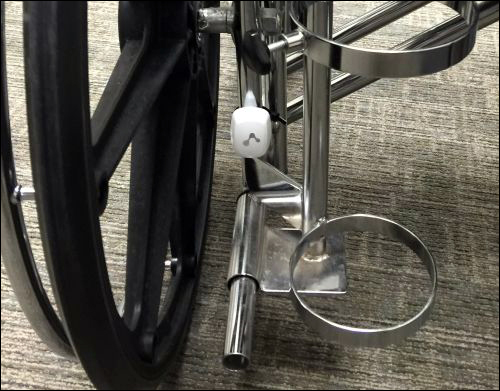Jun 17, 2016THINaër is marketing a real-time location system (RTLS) that employs Bluetooth beacons with built-in sensors. The RTLS consists of THINaër's Bluetooth beacons and receivers, along with cloud-based software that provides the necessary analytics to understand the meaning behind the locations and movements of items and individuals, as well as any sensor-related data.
The solution is currently targeted at health-care and aerospace companies, as well as the oil and gas industries. However, THINaër notes, it could be used in other sectors as well, such as logistics or retail. One health-care provider has already launched a permanent THINaër deployment to locate assets, and potentially personnel and patients, while other companies are still in trials that began earlier this year.
THINaër designed its technology to be easy to launch and access, and to cost less than traditional RTLS solutions that utilize active RFID or Wi-Fi technologies, or that require their own (or a third party's) software to manage the collected data. The company's beacon tags come in a variety of form factors and have built-in temperature and humidity sensors, according to Bryan Merckling, the company's CEO.
The beacon tags, which have a typical battery life of six years, provide status updates regarding temperature and humidity levels, or simply transmit a unique identifier if sensors are not being used. THINaër's Cirrus receivers can be plugged into a wall outlet or a PC's USB port, or can utilize battery power so that they can be attached to walls, ceilings or other surfaces. So far, Merckling says, most companies are using the receivers plugged into computers or AC outlets.
Merckling, formerly IBM's worldwide software strategy director, founded THINaër as BlueKloud 15 months ago, to offer a solution that captures location and sensor data in real time, and then uploads it to a software-as-a-service (SaaS) platform on its own hosted server to enable analytics based on that data. Telecommunications and mobile device management company Advantix purchased BlueKloud in February 2016 and, shortly thereafter, gave the company its current name.
Advantix's offer came at a time when BlueKloud was ready to begin testing its products with customers, after approximately a year of early development. "We had reached a point where we had to decide if it made sense to seek out venture capital and investors, or find an acquisition partner," Merckling says. Ultimately, he notes, BlueKloud and Advantix agreed on the acquisition.
"Advantix happened to be a perfect fit," Merckling states. The advantage for THINaër, he says, is access to customers that Advantix already has secured for its mobile-device and telecom-based solutions. "The low-hanging fruit for an ROI is location-based data, and Advantix already knows how to have that conversation with customers."
THINaër has since been deploying its technology in a handful of pilots in the health-care and aerospace sectors. Installations have ranged from as small as a few rooms on a single hospital wing, tracking about 500 tagged items, to thousands of items across an entire facility.
The proprietary platform can monitor thousands of locations and millions of beacons simultaneously, Merckling says, while layering in additional data. The result is what BlueKloud calls "multi-structured data" that fits into three categories: structured proximity data (for example, "Where are my assets, employees and inventory, and where have they been?"), structured meta-data ("What is the current and historical temperature and humidity of assets and inventory, as well as maintenance cycles and last maintained dates?") and unstructured data. The latter category includes physician logs, nurses' notes, maintenance logs and device-recall notices captured on the internet and linked to location data from the THINaër system.
Aerospace companies, Merckling reports, are employing THINaër's technology to track the locations of aircraft parts that are being assembled. In health-care deployments, Cirrus receivers are installed in patient rooms and some hallways, with tags zip-tied to such assets as wheelchairs, beds or patient care equipment. As those tags transmit their unique identifiers, the receivers capture their signals and forward the collected data to the cloud-based server, via a Wi-Fi or cellular connection. THINaër's software links each tag's corresponding asset with the location (generally a room) of the Cirrus device that last received that tag's signal. The software's Overlook functionality can also identify inaccurate read location data, which it disregards.
"Through machine learning, THINaër continually optimizes [location] accuracy so there is no need to adjust broadcast signal strength of the beacons based on smoke walls or firewalls," Merckling says. "THINaër is continually learning about your site and assets, along with how they interact with every scan, building a history to predict usage in the future."
Hospitals can then use the location information to know not only where equipment is located in real time, but also its history, and can begin tracking such details as how that equipment is being used, by whom (if staff members wear tags on lanyards or badges, or if patients wear wristbands with built-in beacons), and when a particular device was cleaned or maintained.
"The return on investment is in the predictive analytics this provides," Merckling states. "It allows companies, for the first time. to understand the true cost of care. This is info that's never been available" before, he notes, unless users were able to invest in an RTLS solution and the infrastructure required to make it work.
THINaër's software is hardware-agnostic, Merckling adds, so deployments of its system could use RFID technology as well, for situations in which some items require a tag that is less expensive than the beacon tags. For instance, they could be utilized for cold chain tracking or logistics applications.
The company is also developing a Bluetooth beacon in the form of a patch that could be worn by patients. In that case, Merckling explains, the patch could come with a temperature and heart beat sensor, and could transmit that data to the server in order to monitor a patient's health status. There is no specific release date yet planned for the patch, he says.



